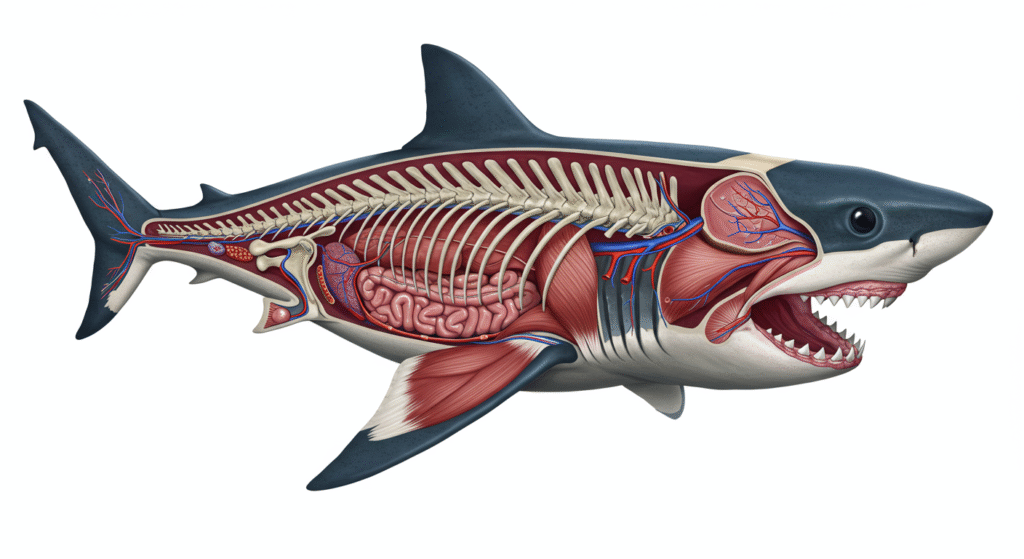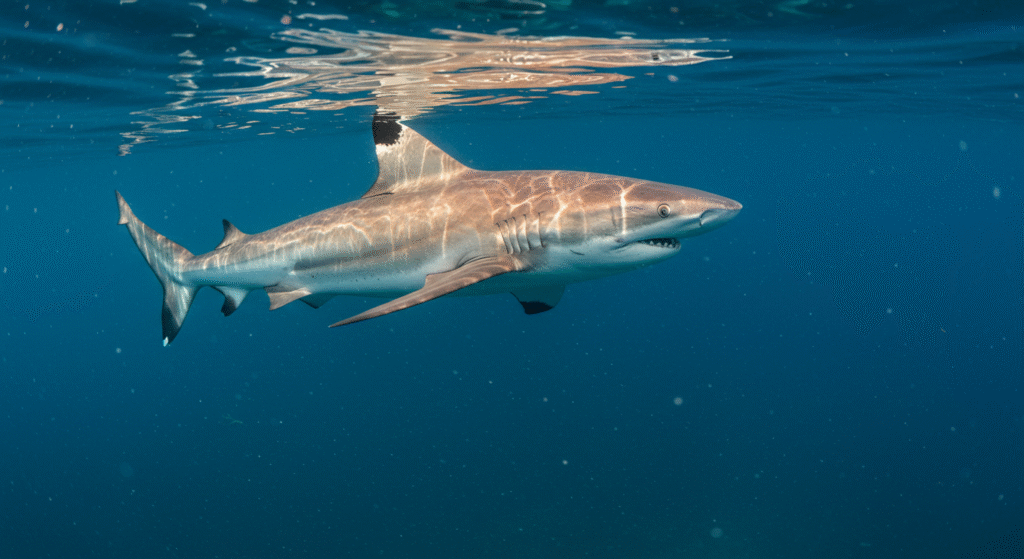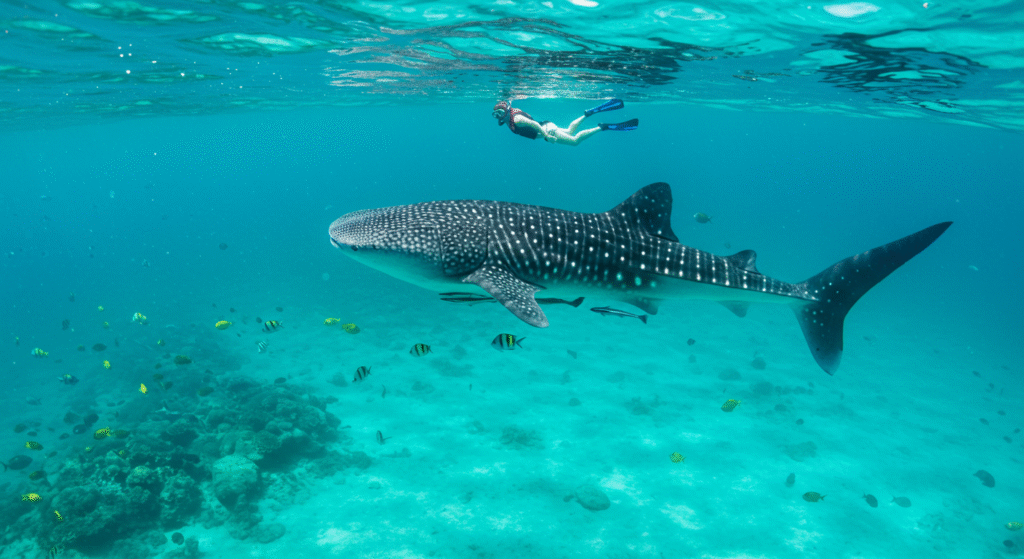Sharks are among the most misunderstood creatures on Earth. Often portrayed as fearsome predators, these incredible animals play an essential role in maintaining the health and balance of marine ecosystems. They continue to amaze scientists and ocean lovers with their extraordinary senses and inspire curiosity through interesting facts about sharks.
But beyond the fear and mystery lies a creature that’s truly fascinating. Whether you’re an ocean lover, a curious mind, or you enjoy snorkeling in locations like Cancun, you’re in for a treat. We gathered 110 interesting facts about sharks that will leave you in awe and make you eager to learn more about ocean wonders.
Evolution and History
1. Sharks have been around for over 400 million years older than dinosaurs.
2. Fossils suggest early sharks had armored scales but lacked true bones.
3. The Megalodon, an ancient shark, was three times the size of a great white.
4. Some modern sharks have hardly changed in millions of years (e.g., frilled shark).
5. Sharks survived five mass extinction events.
Diversity of Shark Species
6. There are over 500 species of sharks globally.
7. Sharks range in size from the 8-inch dwarf lanternshark to the 40-foot whale shark.
8. New shark species are discovered nearly every year.
9. Sharks are found in every ocean and some rivers.
10. Whale sharks are the largest fish species alive today.
Anatomy and Physical Adaptations

11. Sharks have no bones; their skeletons are made entirely of cartilage.
12. Their skin is covered in dermal denticles, making it feel like sandpaper.
13. Sharks replace their teeth throughout their lives; some lose thousands.
14. Great white sharks have up to 300 teeth in multiple rows.
15. The hammerhead’s head shape enhances sensory perception and vision.
16. Sharks can detect minute electrical fields using ampullae of Lorenzini.
17. Some sharks are warm-blooded, helping them hunt in colder waters.
18. Their liver helps with buoyancy, replacing the need for a swim bladder.
19. Some sharks can glow in the dark via biofluorescence.
20. Sharks have an incredible sense of smell; they can detect blood from far distances.
Habitat and Distribution
21. Sharks inhabit all five major oceans.
22. Bull sharks can survive in both saltwater and freshwater.
23. Greenland sharks live beneath Arctic ice and are among the deepest dwellers.
24. Some sharks are found in coral reefs, others in the open ocean, and some on the sea floor.
25. Whale sharks migrate thousands of kilometers annually.
Feeding and Hunting Behavior
26. Sharks exhibit various feeding strategies: filter feeding, ambush hunting, and scavenging.
27. Whale sharks and basking sharks are filter feeders.
28. Tiger sharks have a reputation for eating almost anything.
29. Mako sharks are the fastest species, capable of reaching 60 mph.
30. The thresher shark uses its tail to strike and stun prey.
Reproduction and Lifespan
31. Sharks reproduce through three methods: oviparity, viviparity, and ovoviviparity.
32. Whale sharks give birth to live young, not eggs.
33. Some female sharks can reproduce through parthenogenesis without males.
34. Shark gestation periods can last up to two years.
35. Greenland sharks can live over 400 years, the longest known vertebrate lifespan.
Behavioral Insights

36. Sharks do not sleep like humans; many must keep swimming to breathe.
37. Some sharks enter a state called tonic immobility when flipped over.
38. They can navigate using Earth’s magnetic field.
39. Sharks are typically solitary but may aggregate in feeding or mating grounds.
40. Hammerhead sharks may form large seasonal schools.
Whale Sharks: The Gentle Giants

41. Whale sharks can weigh up to 20 tons.
42. Their spots are unique, like fingerprints.
43. Whale sharks swim slowly at the surface ideal for observation.
44. They filter up to 6,000 liters of water per hour while feeding.
45. Despite their size, they pose no threat to humans.
Sharks and Humans
46. Sharks are not naturally aggressive toward humans.
47. Shark attacks are extremely rare and usually accidental.
48. You’re statistically more likely to be hit by lightning than bitten by a shark.
49. Over 100 million sharks are killed annually, mainly for their fins.
50. Shark finning is a major threat to many species.
51. Marine protected areas and legislation are key to shark conservation.
52. Eco-tourism, like shark diving, supports awareness and preservation efforts.
Conservation Status
53. Many shark species are classified as endangered or vulnerable.
54. Habitat destruction and overfishing are primary threats.
55. Bans on shark finning exist in several countries but enforcement varies.
56. Tracking programs help monitor migration and behavior for conservation planning.
57. Public education is crucial to dispel myths and encourage protection.
Lesser-Known and Rare Species
58. The goblin shark has a protruding jaw and pinkish skin.
59. The cookiecutter shark leaves circular wounds on larger animals.
60. The wobbegong is a carpet shark known for camouflage.
61. Sawsharks have elongated snouts with teeth, used to slash prey.
62. Epaulette sharks can “walk” on land using their fins.
Noteworthy Records and Superlatives
63. Fastest: Mako shark.
64. Largest: Whale shark.
65. Longest-lived: Greenland shark.
66. Deepest-diving: Portuguese dogfish.
67. Most aggressive (statistically): Bull shark.
68. Smallest: Dwarf lanternshark.
69. Widest migration: Great white sharks can travel over 12,000 miles.
70. Most teeth: Frilled sharks have over 300 needle-like teeth.
Sharks in Pop Culture & Myths busted
71. Out of over 500 shark species, only a handful are considered potentially dangerous to humans
72. You’re statistically more likely to be struck by lightning or stung by a bee than bitten by a shark
73. Sharks don’t intentionally hunt humans; most bites are cases of mistaken identity.
74. Some sharks, like nurse sharks, can rest on the seafloor and don’t need to swim constantly.
75. Whale sharks and basking sharks have no sharp teeth and feed on plankton.
76. Most shark bites are investigative “test bites,” not acts of aggression.
77. Sharks have long been feared in myths, often portrayed as sea monsters or omens.
78. The 1975 film Jaws dramatically altered public perception and increased fear of sharks.
79. Ironically, Jaws also sparked a global movement toward shark conservation awareness.
80. Hawaiian culture sees some sharks as aumakua, or guardian spirits of families.
81. In Maori tradition, shark deities like Mataora protect fishermen and are revered, not feared.
Fascinating Shark Trivia
82. Some deep-sea sharks, like the lantern shark, can glow in the dark thanks to bioluminescent cells, helping them blend in or attract prey.
83. Whale sharks, the largest fish in the sea, are gentle filter feeders that consume tiny plankton by swimming with their mouths wide open.
84. Sharks have existed for over 400 million years, making them older than trees and survivors of multiple mass extinctions.
85. A shark’s liver can comprise up to 25% of its body weight, filled with oil for buoyancy and long-term energy storage.
86. When flipped upside down, some sharks enter a trance-like state called tonic immobility, often used by researchers for safe handling.
87. Tiger sharks are known as the “garbage cans of the sea” due to their habit of eating nearly anything, including man-made objects.
88. Basking sharks feed by gliding through the water with open mouths, filtering plankton, and posing no threat to humans.
89. Shark teeth are naturally coated in fluoride, making them highly resistant to decay and essentially self-cleaning.
90. Sharks have been around longer than Mount Everest, with ancient ancestors predating the formation of the Himalayas by millions of years.
91. Blue sharks are long-distance travelers, capable of migrating thousands of miles across entire ocean basins.
92. Shark teeth are embedded in gums and arranged in conveyor-belt-like rows that continuously rotate new teeth forward.
Rare & Mind-Blowing Shark Facts
93. Many sharks prefer cool, deep waters which support prey abundance and help regulate their energy-efficient metabolism.
94. The megamouth shark, a rare deep-sea species, was only discovered in 1976, proving there’s still much to learn about sharks.
95. In several shark species, females are larger than males, which may aid in pup development and protect them during gestation.
96. Some sharks navigate the oceans using Earth’s magnetic fields, functioning like a built-in GPS for long migrations.
97. Sharks have been observed rubbing against kelp forests, possibly to remove parasites or dead skin in a form of natural grooming.
98. Not all sharks must swim to breathe bottom-dwellers like nurse sharks can pump water over their gills while stationary.
99. Sharks rarely develop cancer, a trait that intrigues researchers seeking insights into human cancer resistance.
100. Scalloped hammerhead sharks school together in large groups during the day, breaking apart to hunt solo at night.
101. A shark’s dorsal fin is crucial for balance and agility, helping them make sharp turns and stay stable while swimming.
Shark Fun Facts
102. Sharks can get sunburned just like humans, especially surface-dwelling species like hammerheads which have been found with sun-damaged skin.
103. Some deep-sea sharks are bioluminescent and can glow in the dark to camouflage or attract prey.
104. Greenland sharks are the longest-living vertebrates on Earth, with lifespans estimated to exceed 400 years.
105. Sharks don’t blink like humans; they use a protective membrane called a nictitating membrane that slides over their eyes during attacks.
106. Shark teeth are naturally coated with a fluoride-like material, making them cavity-resistant and stronger than human teeth.
107. Cookiecutter sharks feed by taking perfect circular bites out of larger animals, leaving distinctive wounds even on submarines!
108. The epaulette shark can survive for hours out of water and “walk” across tide pools using its fins during low tide.
109. Sharks have belly buttons after birth, a small scar remains where the yolk sac was attached, similar to a navel.
110. Some sharks enter a trance-like state called tonic immobility when flipped upside down, becoming temporarily paralyzed and calm.
Sharks You Might See Near Cancun
Cancun’s clear, warm Caribbean waters are home to a variety of fascinating marine species, including several types of sharks. While dangerous encounters are exceedingly rare, you may spot:
- Nurse Sharks: Docile bottom-dwellers often seen near reefs.
- Caribbean Reef Sharks: Common around island dive spots.
- Whale Sharks: Gentle giants that migrate to the area from May to September.
Snorkeling or joining a yacht tour with Catamaran Tours Cancun increases your chances of encountering these majestic creatures in a safe, guided setting.
If you’re a catamaran lover looking for the ultimate marine adventure, check out our best Cancun snorkeling tours for catamaran lovers. It’s the perfect way to explore the underwater world and maybe even spot a shark or two!
Book a Marine Tour to Spot Sharks in the Wild
Ready to see marine life up close? Join a catamaran or snorkeling tour with Catamaran Tours Cancun for a chance to witness the beauty of sharks in their natural habitat. Our guided tours are safe, educational, and unforgettable.
Final Thoughts
Understanding sharks through interesting facts about sharks helps us appreciate their role in the ocean and reduces irrational fears. Sharks are not monsters but vital players in our marine world. Educating yourself and others leads to more informed decisions about ocean conservation.
Ecotourism, such as snorkeling and marine life tours, supports conservation by showing people the beauty of these animals and generating funds for protection efforts. The more we know, the more we protect.
FAQs
Are sharks really attracted to human blood?
Not specifically. Sharks have an acute sense of smell and can detect blood in the water from long distances, but they are more attracted to fish blood or bodily fluids from their natural prey than human blood.
Can I see sharks while snorkeling in Cancun?
Yes, but safely! While shark sightings are rare during casual snorkeling, gentle species like nurse sharks or even whale sharks (during season) can sometimes be seen on guided tours.
Why do sharks have belly buttons?
Because baby sharks develop internally and receive nourishment via a yolk sac or placenta.
Can sharks really “walk” out of water?
Yes! Epaulette sharks have learned to essentially walk with their fins; they hold their breath and slow their heart rate then begin to walk across the reef. This unique behavior helps them traverse tide pools and shallow reefs.


